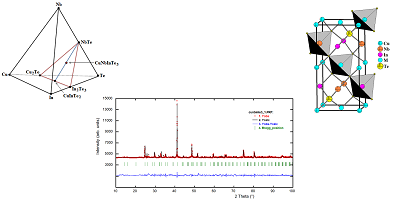Synthesis, X-Ray Diffraction (XRD), Differential Thermal Analysis (DTA), and Scanning Electron Microscopy (SEM) of the Alloy (CuInTe2)1-x(NbTe)x with x=0.5

- chalcogenide alloys; superconductor; thermal analysis; crystal structure; powder X-ray diffraction; Rietveld method
Abstract
A polycrystalline ingot (30mm long, 10mm diameter) of the alloy (CuInTe2)1-x(NbTe)x with x=0.5 has been produced using the melt and anneal technique and characterized by X-Ray Diffraction (XRD), Diferential Thermal Analysys (DTA) and Scanning Electron Microscopy (SEM). From XRD results, and using Rietveld refinement method, the crystal structure has been obtained indicating than this alloy crystallizes in a chalcopyrite-like structure, space group (Nº 112), unit cell parameters a = 6.1933(2) Å, c = 12.4293(2) Å, V = 476.75(2) Å3, figures of merit Rexp= 6.7%, Rp= 7.5%, Rwp= 7.3%, and S = 1.1. DTA measurements indicate three thermal transitions at 1028, 977 and 886 K in the heating cycle, and 1016, 900 and 848 K in the cooling. The transitions at 1028 and 1016 correspond to the melting and solidification point, respectively; the transitions at 977 and 900 K are of solid to liquid+solid type, whereas the transitions at 886 and 848 K correspond to order-disorder. The melting point is incongruent. In the diffraction pattern, traces of a secondary phase are observed; this phase has been identified using SEM technique as (CuIn)0.5NbTe2.
